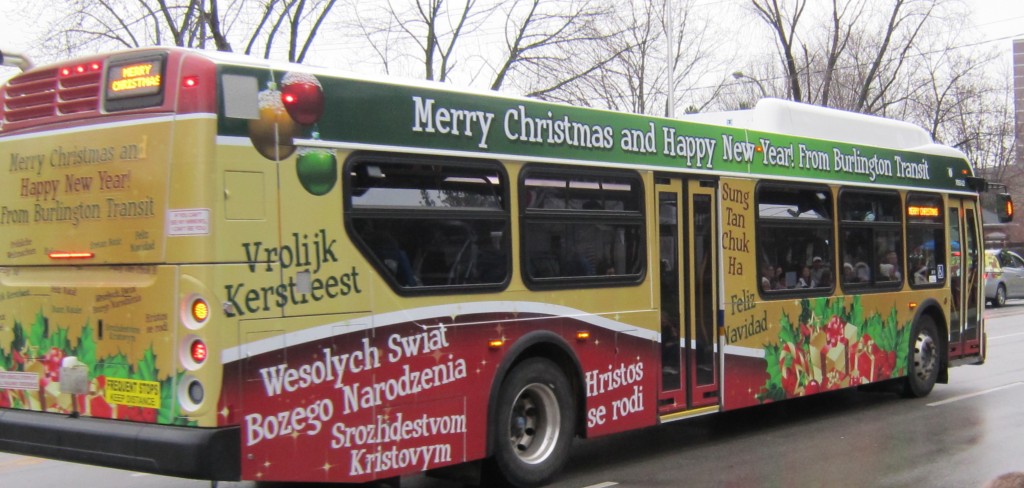 By Staff
By Staff
February 23, 2015
BURLINGTON, ON
Members of Council ask questions of city staff. Both the questions and the answers are set out in public reports.
Here is a zinger for you.
Question: What is the approximate subsidy per passenger for transit?
Is it the 2015 net operating budget $9,314,989 divided by projected riders of 2,335.000 = $3.9 per ride?
Answer

Burlington Transit put their most festive bus into the Santa Claus parade. The language doesn’t matter – the message is still the same. The issue fir transit is not public perception but more public use.
Conventional cost per ride for 2015 is projected to be $3.47 – based on 2,335,000 rides.
When the budget is approved at Council this evening a fare increase will be put in place – but it won’t cover the operating cost as shown in the information above.
Burlington has some deep thinking to do on just what it wants in the way of a public transit service. Oakville has significantly different operating numbers than Burlington – fully understanding why is the transit Burlington faces.



















“Extreme inequality is morally repugnant, an injustice to the basic notions of fairness on which we base our civilization. It demands a substantive response.
A city cannot be inclusive if its transportation system assumes that everyone will drive. Such a city marginalizes families that cannot afford a car and isolates aging seniors who can no longer drive.
It also alienates young people, who increasingly want cities that provide a mix of transportation options. The days of regarding a driver’s licence as a ticket to freedom are ending: most millennials prefer to live in places that emphasize walking, cycling and transit over driving.”
https://www.thespec.com/opinion-story/4900230-the-city-we-need-a-vital-signs-perspective/
The $9,315,000 figure also includes things like the over $3 million per year Burlington has to pay GO Transit. So that makes it $6 million as I see it.
For Sports and Recreation it’s $13,200,000:
$3,120,000 is the subsidy from City Taxes for “Organized Sport Support”
$4,350,000 is the subsidy from City Taxes for “Parks and Open Space – Maintenance”
$5,730,000 is the subsidy from City Taxes for “Recreation”
Just saying.
Does anyone actually believe Burlington can become the first transit system in a low-density suburban community to pay its entire operating cost from the fare box? Dream on!
Even the TTC cannot fund its operations only from the fare box. An analysis of the TTC from many years ago identified only one of its routes, (Spadina) as self-supporting.
There is some disturbing language coming from City Hall. Transit expenditures are not called investments, but are instead referred to as a subsidy. We don’t hear council and staff refer to our enormous road budget as the ‘car subsidy’. Nor do they refer to the parks, recreation, library, or fire service as subsidy.
A recent article by Ryan McGreal(1,2) found that Waterloo’s large investments in transit were going to more than pay for themselves in future reductions in road expenditures. This is a much better way to address the so-called road infrastructure gap, than by removing money from transit to re-pave more side streets and cul-de-sacs.
(1) https://www.raisethehammer.org/article/2496/what_does_hamilton_know_that_waterloo_region_does_not
(2) https://www.thespec.com/opinion-story/5337154-hamilton-s-inertia-on-lrt-may-prove-costly/
Doug Brown, Chair
Burlington for Sustainable Accessible Transit (BFAST)
[…] article was published today in the Burlington Gazette which focused on the ‘subsidy’ per transit […]
Here’s a thought, how about something absolutely outrageous, and bizarre, like increasing fares so the ridership actually pays for the service.
There is a major problem with transit in our city, and I think we all can at least agree on that. So what will it take to solve that problem? Money. Plain and simple.
The primary challenge in our city, and this is why Council is having such a hard time wrestling with this, is that the general population is strongly against the one thing that will bring in the money that is so desperately needed. Development. Up until recent years, we’ve always had greenfield development and have prospered because of it. Now that intensification is the only option, attitudes have changed, and “development” has become worse than a 4-letter word. How do you compensate for loss of development charges? You can’t.
If we’re comparing Oakville to Burlington, then count the number of cranes and construction sites in Oakville. Then count the number of cranes and construction sites in Burlington. Oakville has development, Burlington does not. Oakville is earning enormous sums of money through development charges. Burlington is not. Oakville is making wise business decisions and growing its city. Burlington sits idle. This isn’t rocket science.
No development = no money = no transit improvements.